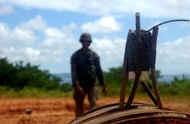Marine Headline News
CAB
Marines create craters
CENTRAL TRAINING
AREA, OKINAWA, Japan — Hunched behind a hill, wearing flak
jackets and Kevlar helmets, a group of Marines anxiously
awaits the destructive vibrations of the strategically placed
explosives. The group of Marines yells, “Fire in the
hole!” three times in unison.
A combat engineer
squeezes the detonation switch, sending an electrical charge
more than 20,000 feet per second through 50 feet of detonation
cord attached to a 2-pound, 8-ounce block of plastic explosive
placed on a door.
Boom! The explosion
shakes the earth and sends debris and dust throughout the
training area.
Marines with Combat
Engineer Company, Combat Assault Battalion, 3rd Marine
Division, used improvised and makeshift explosives to breach
or destroy obstacles during training here June 29 - July 1.
“In combat zones,
the CAB Marines’ duty is to provide passage to objectives
for infantry units,” said 2nd Lt. Alan J. Imperiale, platoon
commander. “Providing entry requires the Marines of CAB to
be proficient.”
If there is an
obstacle that needs to be breached or destroyed during a
wartime situation, it is up to these Marines to do just that,
according to Sgt. Daniel C. Verduce, combat engineer.
“We conduct this
training to learn advanced techniques adapted from the basic
skills learned at (Military Occupation Specialty) school,”
said Verduce. “A lot of the detonations we used were
improvised by using common items.”
Many materials such
as C-4 plastic explosive, detonation cord, concertina wire,
plywood and an old champagne bottle were implemented into the
three-day training.
“I need to know
if I am to use a shape charge or corner force charge,”
Verduce said. “A shape charge is an explosive used to
puncture a hole into something like a vehicle, and a corner
force charge is used to destroy pillars on a bridge.”
The combat
engineers created an improvised shape charge by placing C-4
into the base of a champagne bottle, propping it up with
sticks and detonating it atop old construction equipment. They
punctured a hole through the 4-foot-2-inch piece of steel.
Knowing how to
implement the correct amount and kind of explosives is art
within itself, explained combat engineer Lance Cpl. Philip D.
Goffena.
“Our training
days were long, but it gave us an ample amount of time to
prepare our explosives,” said Gunnery Sgt. William J.
Grigsby, platoon sergeant. “The charges we use are extremely
dangerous, so the safety of our Marines is paramount.”
CENTRAL
TRAINING AREA, OKINAWA, Japan – Marines
examine a steel door strapped with explosive here June 30. The
Marines with Combat Engineer Company, Combat Assault
Battalion, 3rd Marine Division, used improvised and makeshift
explosives to breach or destroy obstacles during training here
June 29 - July 1.
(U.S. Marine Corps Photo by
Lance Cpl. Joel Abshier)(Released)
